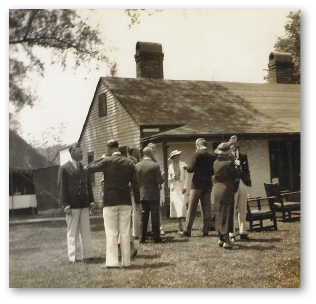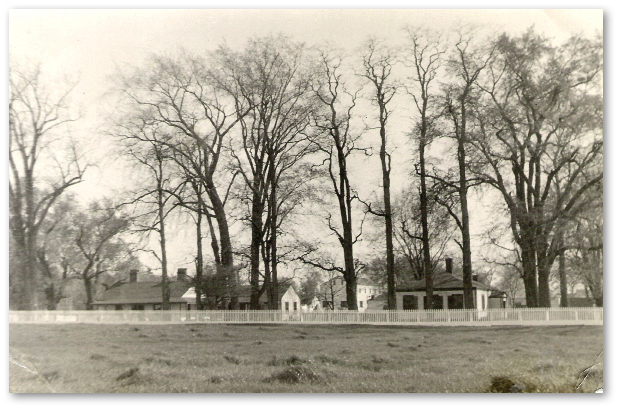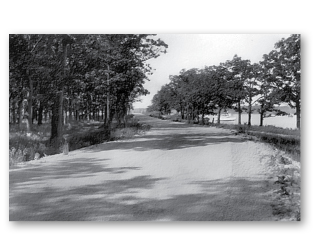Chapter 15
Between the Wars
Now that the war to end all wars was finally over, there was less interest in summer camps for the militia. Moreover, a much greater proportion of defence spending was directed towards the fledgling Canadian air force and navy. Camp Niagara, even with the lakeshore properties, could not provide the space or resources of the much larger camps in Quebec and Manitoba. Nevertheless, and much to the relief of the local population, Camp Niagara resumed in the summer of 1921. The extensive wartime practice trenches on the Fort George Commons were gradually filled in[1] as were some of the trench works on the Mississauga Commons.[2] The Niagara Golf Club eventually reclaimed the latter for their golf links.

RCR’s garden party, photo, circa 1936. Garden parties in the compound for the military personnel, their families, and invited townsfolk were popular events during the Depression. Behind is the former Junior Commissariat Officer’s Quarters, still standing today awaiting restoration.
Courtesy of Peter Moogk.
Two regular army units were assigned to Camp Niagara for the duration of the summer: the infantry Royal Canadian Regiment (RCR) and the Royal Canadian Dragoons (RCD).[3] The Dragoons wintered in Stanley Barracks in Toronto, but there was always great excitement in town when they arrived in the spring. Having ridden for three days from Toronto on their own steeds, the Dragoons usually assembled near the corner of Mary and King Streets. There the cavalrymen and their horses would be “spiffied up” before making their grand parade march into camp at the Centre Street entrance.[4] The officers and NCOs often brought along their wives and families, who would find accommodation in town and return year after year. There was much socializing with the town folk, including town socials, dinners, and dances in the officers’ and sergeant’s messes, garden parties, and even “Christmas in July” celebrations on the campgrounds.[5]

The Compound, photo by Willis Moogk, 1936. Within the picket fence under stately trees on the left is the former Junior Commissariat Officer’s Quarters with newer additions. On the right is the former barrack master’s house. Visible behind is the two-storey soldiers’ barracks.
Courtesy of Peter Moogk.
In addition to improving their own skills, the prime function of the regular regiments was to train the summer militia attendees. After the war the overseas battalions of the Canadian Expeditionary Forces were disbanded and the old named militia units were reactivated. Eventually men from the original 81st, 98th, and 176th CEF battalions during the Great War became the Lincoln and Welland Regiment,[6] the non-permanent active militia in the Niagara Peninsula.
The militia units from the Toronto area still arrived by steamship, while those from southwestern Ontario generally came by train. With reduced resources for the militia, most regiments expected their men to supply their own uniform and boots and received no pay. Many of the trainees arrived only in threadbare civvies and often sub-standard shoes or boots, if any. This became even more desperate in the depths of the Depression. An officer of the prestigious Governor General’s Body Guard, which did supply boots, claimed that “many men signed up to get ‘issue’ boots and the streetcar tickets to attend parade.”[7] The infantry camp provided instruction in the basic skills: the various marching drills, musketry, target practice and general military etiquette. Because so many of the men lacked suitable footwear the route marches were limited to five or six miles.[8] The camp was still under canvas. For the men this entailed sleeping up to nine in a bell tent with only a ground sheet and three blankets. The official uniform for the men, if you could afford it, was still the khaki outfit with stiff collars and putties wrapped around the legs.

Camp Life, A Work Out, photo postcard. During and after the Great War, the cavalry was still an important element of Camp Niagara.
Courtesy of Peter Moogk.
The role of horses in the military was soon to be relegated to strictly occasional formal affairs; however, until the start of the Second World War there was still great emphasis on training men to be “one with their horse.” This not only included troopers in the cavalry regiments, but all infantry field officers and military medical officers. Most of the horses used for training the militia cavalry at Camp Niagara were rented from the Six Nations Reserve near Brantford, Ontario. The Ferrier sergeant had to inspect the horses, most of which were farm horses; not all were halter broken. The chosen horses were then transported by cattle cars to camp. One subaltern in the Governor General’s Body Guard at Camp Niagara in 1933 recalled being assigned to “rough riding detail,” which meant attempting to saddle, bridle, and even ride the unbroken horses so that the horses would be ready for the camp’s rookie incoming troopers. Of the two hundred horses that arrived from the reserve, fifty refused to be ridden and were “hidden” in Paradise Grove to forage for themselves.[9] The cavalry lines were usually set up between the ruins of Fort George and Paradise Grove because of the ready access to water in the river. Much time was spent washing and grooming their mounts but for the most part they practised their riding skills or “equitation.”

Aerial view of the Military Reserve, photo, 1934. Aerial mapping of the country was an important project during the 1920s and 30s. In this view, the restoration of Fort George and Navy Hall has not yet begun. Two race tracks are readily visible, as are several trails. One of the fields northeast of Queen’s Parade was a polo field while the town’s baseball diamond can be seen within the larger track near the present site of the Shaw Festival Theatre.
Canada Department of Energy, Mines & Resources. Niagara air photo, 1934. Ca. 1:6000. Brock University Map Library.
When not instructing, the officers of the Royal Canadian Dragoons practised their “Musical Ride” for which they would return to Toronto in mid-August to perform at the CNE.[10]
To hone their riding skills the Dragoons set up a polo field next to the fort. They also practised the ancient game of tent peg spearing.[11] Arguably, the ultimate goal of the cavalry was to execute an effective “charge” upon the enemy with drawn swords or sabres. The last recorded charge at Camp Niagara was filmed for posterity, but unfortunately the reel has since gone missing:
… one of the most outstanding pieces of filmwork I’ve seen … was a charge we made in line down this big field and there was a post in the middle of the field where the fellow was standing with his camera. And I don’t know if you’ve ever seen a couple of hundred horses with lances coming at you, but the guy’s movie camera just disappears into the sky as he faints dead away.[12]
As with previous camps, the brass and bugle bands, as well as occasional Scottish pipers, were an important part of camp life. Many of the bandsmen were also taught as ambulance stretcher bearers. There were several highly regarded marching bands from the Six Nations Reserve that made the annual trek to Camp Niagara.
Aviation was not an important aspect of Camp Niagara. However, in 1936 the Governor General’s Horse Guards[13] performed exercises during which low flying planes practised dropping “bombs” (bags of flour) on moving targets below (cavalrymen on horses.)[14] Between the wars, Barn Stormers occasionally came to town. These civilian-operated biplanes could land and take off from the grassy Commons. Rides were offered for a stiff fee; acrobatics and parachute demonstrations also were performed. On one occasion, to the horror of all the spectators assembled on the Commons, the performer’s parachute failed to open; on impact, the lifeless body sunk a foot into the turf.[15]
High school “cadets” also trained at Camp Niagara. For these teenagers the two-week camps under canvas were often their first trip away from home. The boys studied the military chain of command, practised drills, enjoyed the swimming parades, and might even venture into a tattoo parlour on Picton Street. There was a cadet corps at the local Niagara High School on Castlereagh Street. They often practised their marching drills after class on the Commons across the street from their school.[16]

Niagara River Parkway, photo, 1934. The old River Road northward from the John Street East intersection along the Niagara River was greatly improved in 1931 by the Niagara Parks Commission prior to the restoration of Fort George and Navy Hall.
Courtesy of Pat Simon and Joe Solomon.
University students attended Camp Niagara with the Canadian Officer Training Corps (COTC). These “gentlemen cadets,” many of whom would eventually become officers in the armed forces, received military instruction during the school year and were expected to attend summer camp for practical training. Many had very fond memories of their summer sojourn on the Commons.[17]
During its long history Camp Niagara was fortunate to have several outstanding camp commandants and brigade commanders. Brigadier Oliver M. Martin, commander of the 13th Brigade, was particularly revered by both the campers and the townspeople.[18] An early riser, this impressive figure would often be seen touring the camp astride his white horse. Born a Mohawk on the Six Nations reserve, he joined the army at age seventeen as a bugler and worked his way up the ranks. After the Second World War he was appointed a magistrate. Firm but always courteous, he was much admired by both his officers and other ranks.
The annual rhythm of the summer camps on the Commons rolled along through the 1930s but the rumblings of yet another world conflict were getting louder. Meanwhile, to the northeast of Queen’s Parade there was much activity with the restoration of Fort George and Navy Hall.